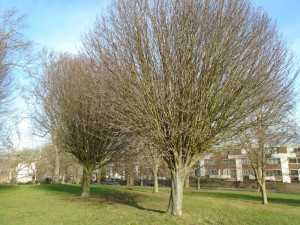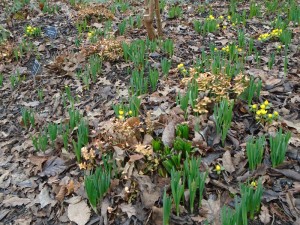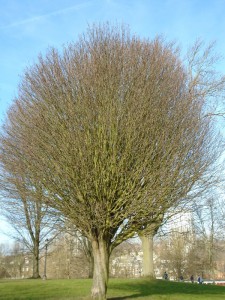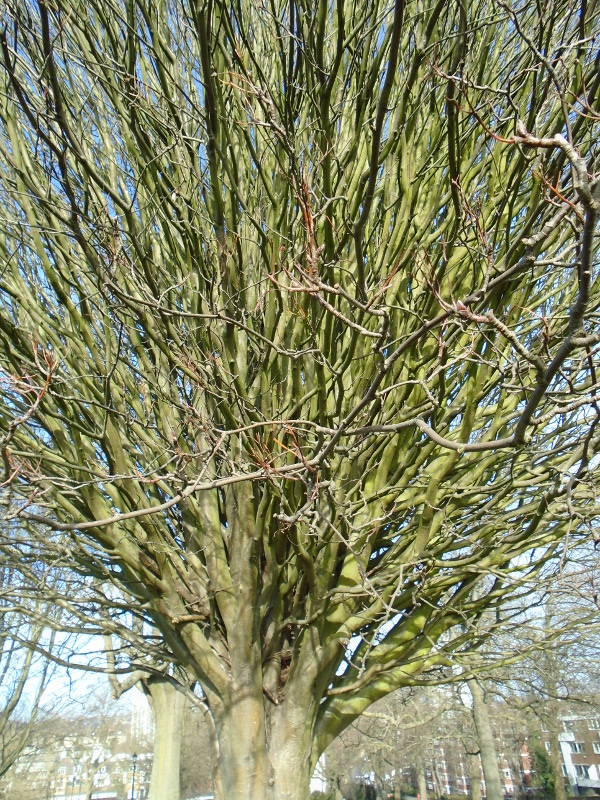Trees on Primrose Hill
 Curse my ignorance: I have been walking past this stand of trees for almost twenty years. And just when I want to write about them for the first time, I cannot locate my tree identification books.
Curse my ignorance: I have been walking past this stand of trees for almost twenty years. And just when I want to write about them for the first time, I cannot locate my tree identification books.
I know where they are; back in France where I’d rather be.
In summer you don’t really notice the extraordinary growth on these trees. How on earth can a canopy be so dense with branches? If anone is shouting at the computer now saying ‘I know, I know what they are called’. Please, put me out of my misery.
I think they are beech. But the trees have no leaves, so I may be barking up the wrong species (sorry, I’ve had a hot chocolate and I’m zinging with sugar).
It is that time of year when you look at everything and think – come on, soon, soon. 
My mystery trees are planted just off the summit of the hill, towards Primrose Hill Road and are poised to come into leaf. I know they are just beyond a marvellous stand of whitebeams – sorbus aria. But the name of these elude me.
Still, I can admire them even if I am ignorant.
And what does the ignorant do? Rummage in the internet of course. I tried tree identification sites on Primrose Hill, and came up empty. But I did discover the birder’s site; dedicated to bird watching in the capital.
And who knew just how many birds our little hill and park contained?
 “The patch really comes into its own during periods of migration. Maybe because it is one of the inner city’s few sizable areas of green, or because it gets so much regular coverage, it does turn up some pretty good birds every year. Wheatears are fairly easy to spot when present but a more detailed look can reveal other interesting visitors such as (annually) Water Rail, Woodcock, Firecrest, Wood Warbler, Spotted and Pied Flycatchers, Common Redstart, Whinchat, Tree Pipit and (more rarely) Waxwing, Ring Ouzel and Stonechat. In autumn especially, the site briefly hosts noteworthy concentrations of leaf warblers (genus Phylloscopus): waves of Willow Warblers in August, and Chiffchaffs in late September and October, can respectively include Wood Warbler and Yellow-browed Warbler (two of each were recorded in 2014).” Thank you londonbirders.wikia.com.
“The patch really comes into its own during periods of migration. Maybe because it is one of the inner city’s few sizable areas of green, or because it gets so much regular coverage, it does turn up some pretty good birds every year. Wheatears are fairly easy to spot when present but a more detailed look can reveal other interesting visitors such as (annually) Water Rail, Woodcock, Firecrest, Wood Warbler, Spotted and Pied Flycatchers, Common Redstart, Whinchat, Tree Pipit and (more rarely) Waxwing, Ring Ouzel and Stonechat. In autumn especially, the site briefly hosts noteworthy concentrations of leaf warblers (genus Phylloscopus): waves of Willow Warblers in August, and Chiffchaffs in late September and October, can respectively include Wood Warbler and Yellow-browed Warbler (two of each were recorded in 2014).” Thank you londonbirders.wikia.com.
